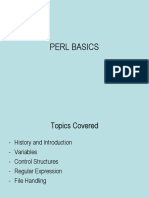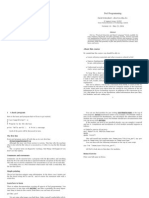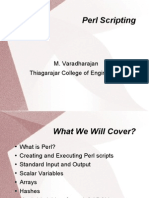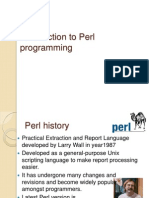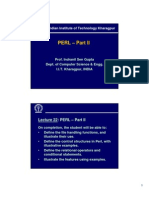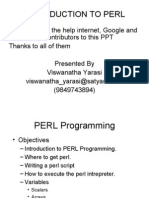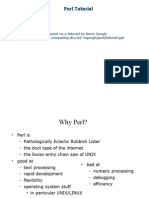Perl Scripting: An In-Depth Tutorial
March 30, 2025
Contents
1 Introduction to Perl 2
2 Setting Up a Perl Environment 3
3 Basic Syntax and Structure 3
3.1 Comments . . . . . . . . . . . . . . . . . . . . . . . . . . . . . . . 3
4 Variables and Data Types 4
4.1 Scalar Variables ($) . . . . . . . . . . . . . . . . . . . . . . . . . . 4
4.2 Arrays (@) . . . . . . . . . . . . . . . . . . . . . . . . . . . . . . 4
4.3 Hashes (%) . . . . . . . . . . . . . . . . . . . . . . . . . . . . . . 5
5 Operators 5
5.1 Arithmetic Operators . . . . . . . . . . . . . . . . . . . . . . . . 5
5.2 String Operators . . . . . . . . . . . . . . . . . . . . . . . . . . . 5
5.3 Comparison Operators . . . . . . . . . . . . . . . . . . . . . . . . 6
5.3.1 Numeric Comparisons . . . . . . . . . . . . . . . . . . . . 6
5.3.2 String Comparisons . . . . . . . . . . . . . . . . . . . . . 6
5.4 Logical Operators . . . . . . . . . . . . . . . . . . . . . . . . . . . 6
6 Control Structures 6
6.1 Conditionals (if, elsif, else, unless) . . . . . . . . . . . . . . 6
6.2 Loops . . . . . . . . . . . . . . . . . . . . . . . . . . . . . . . . . 7
6.2.1 for Loop . . . . . . . . . . . . . . . . . . . . . . . . . . . 7
6.2.2 foreach Loop . . . . . . . . . . . . . . . . . . . . . . . . . 7
6.2.3 while, until . . . . . . . . . . . . . . . . . . . . . . . . . 7
6.2.4 Loop Controls: next, last, redo . . . . . . . . . . . . . . 7
7 Subroutines (Functions) 8
8 I/O Operations 8
8.1 Reading from STDIN . . . . . . . . . . . . . . . . . . . . . . . . . 8
8.2 Writing to STDOUT . . . . . . . . . . . . . . . . . . . . . . . . . 8
8.3 Command-Line Arguments . . . . . . . . . . . . . . . . . . . . . 8
1
�9 Regular Expressions (Regex) 9
9.1 Match: = /̃pattern/ . . . . . . . . . . . . . . . . . . . . . . . . . 9
9.2 Substitution: s/// . . . . . . . . . . . . . . . . . . . . . . . . . . 9
9.3 Transliteration: tr/// . . . . . . . . . . . . . . . . . . . . . . . . 10
10 References and Complex Data Structures 10
10.1 Creating References . . . . . . . . . . . . . . . . . . . . . . . . . 10
10.2 Dereferencing . . . . . . . . . . . . . . . . . . . . . . . . . . . . . 10
10.3 Anonymous References . . . . . . . . . . . . . . . . . . . . . . . . 10
10.4 Nested Data Structures . . . . . . . . . . . . . . . . . . . . . . . 11
11 Modules and Packages 11
11.1 CPAN . . . . . . . . . . . . . . . . . . . . . . . . . . . . . . . . . 11
12 File Handling 12
12.1 Reading from a File . . . . . . . . . . . . . . . . . . . . . . . . . 12
12.2 Writing to a File . . . . . . . . . . . . . . . . . . . . . . . . . . . 12
12.3 Appending to a File . . . . . . . . . . . . . . . . . . . . . . . . . 12
13 Additional Topics 12
13.1 Taint Mode . . . . . . . . . . . . . . . . . . . . . . . . . . . . . . 12
13.2 Special Variables . . . . . . . . . . . . . . . . . . . . . . . . . . . 13
13.3 One-Liners . . . . . . . . . . . . . . . . . . . . . . . . . . . . . . 13
14 Best Practices 13
15 Conclusion 14
1 Introduction to Perl
Perl (Practical Extraction and Reporting Language) is a high-level, dynamic
programming language originally developed by Larry Wall in 1987. It excels
at text processing, system administration, and web development, among other
domains. A common Perl motto, "There’s more than one way to do it" (TM-
TOWTDI), reflects the language’s flexibility in problem-solving.
Key features of Perl:
• Strong text processing capabilities: Regular expressions are deeply
integrated.
• Dynamic typing: Variables’ types are inferred at runtime.
• CPAN (Comprehensive Perl Archive Network): A large repository
of community-contributed modules.
2
� 2 Setting Up a Perl Environment
Most Unix-like systems (Linux, macOS) come with Perl pre-installed. Check
with:
1 perl -v
If Perl is not installed:
• Linux: Use your package manager, e.g., apt-get install perl or yum
install perl.
• macOS: Often already installed; if not, install via brew install perl.
• Windows: Use Strawberry Perl (includes a C compiler) or ActivePerl.
Run scripts with:
1 perl your_script.pl
Or start an interactive shell (debugger) with:
1 perl -de 1
3 Basic Syntax and Structure
A minimal Perl script:
1 #!/usr/bin/perl
2 use strict;
3 use warnings;
4
5 print "Hello, World!\n";
Shebang line: #! /usr/bin/perl tells the system which interpreter to use.
use strict and use warnings: Enforce good coding practices, catch errors
early.
Printing: print outputs to STDOUT.
3.1 Comments
Single-line comments use the # symbol:
1 # This is a single-line comment
For multi-line commentary, Perl does not have a native multi-line comment
syntax; use POD (Plain Old Documentation) if extensive commenting is needed.
3
� 4 Variables and Data Types
Perl has three primary data types, each with its own sigil (prefix):
• Scalars: $variable
• Arrays: @array
• Hashes: %hash
4.1 Scalar Variables ($)
A scalar can hold a string, number, or reference:
1 my $name = "Alice";
2 my $age = 30;
3 my $score = 95.5;
String Interpolation:
1 print "Name: $name\n"; # interpolates $name
2 print ’Name: $name\n’; # does not interpolate
Variable Context: Automatic conversion between numeric and string context:
1 my $mixed = "42";
2 my $sum = $mixed + 10; # interpreted as number => 52
4.2 Arrays (@)
Arrays are ordered lists of scalars:
1 my @fruits = ("apple", "banana", "cherry");
Accessing Elements:
1 print $fruits[0]; # apple
2 print $fruits[1]; # banana
Special Indices and Length:
1 my $last_index = $#fruits; # last index
2 my $count = scalar(@fruits); # number of elements
Adding & Removing Elements:
1 push @fruits, "date"; # add to end
2 my $popped = pop @fruits; # remove from end
3
4 unshift @fruits, "mango"; # add to front
5 my $shifted = shift @fruits; # remove from front
Array Slices:
1 my @subset = @fruits[0,2]; # get elements at indices 0 and 2
4
� 4.3 Hashes (%)
Hashes store key-value pairs:
1 my %capitals = (
2 "France" => "Paris",
3 "Germany" => "Berlin",
4 "Switzerland" => "Bern"
5 );
Accessing and Modifying:
1 print $capitals{"France"}; # Paris
2 $capitals{"Spain"} = "Madrid"; # add new pair
Keys and Values:
1 my @countries = keys %capitals; # all keys
2 my @city_names = values %capitals; # all values
3
4 while ( my ($country, $city) = each %capitals ) {
5 print "Country: $country -> City: $city\n";
6 }
Deleting Entries:
1 delete $capitals{"France"};
5 Operators
5.1 Arithmetic Operators
• +, -, *, /, % (modulus)
• ** (exponentiation)
1 my $x = 10;
2 my $y = 3;
3 print $x + $y; # 13
4 print $x % $y; # 1
5 print $x ** $y; # 10^3 = 1000
5.2 String Operators
• Concatenation (.):
1 my $str = "Hello" . " " . "World"; # "Hello World"
• Repetition (x):
1 my $repeat = "Ha" x 3; # "HaHaHa"
5
� 5.3 Comparison Operators
5.3.1 Numeric Comparisons
==, !=, <, >, <=, >=
1 if ($x == $y) {
2 print "Equal numbers\n";
3 }
5.3.2 String Comparisons
eq, ne, lt, gt, le, ge
1 if ($name eq "Alice") {
2 print "Hello, Alice!\n";
3 }
5.4 Logical Operators
&& (AND), || (OR), ! (NOT) and their lower-precedence counterparts and, or,
not.
1 if ($x < 10 && $y > 5) {
2 print "x < 10 AND y > 5\n";
3 }
6 Control Structures
6.1 Conditionals (if, elsif, else, unless)
1 my $age = 18;
2
3 if ($age < 13) {
4 print "Child\n";
5 } elsif ($age < 20) {
6 print "Teen\n";
7 } else {
8 print "Adult\n";
9 }
10
11 # unless is the logical opposite of if
12 unless ($age > 18) {
13 print "You are not older than 18.\n";
14 }
6
� 6.2 Loops
6.2.1 for Loop
1 for (my $i = 0; $i < 5; $i++) {
2 print "i = $i\n";
3 }
6.2.2 foreach Loop
1 my @colors = ("red", "green", "blue");
2 foreach my $color (@colors) {
3 print "$color\n";
4 }
5
6 # Shorthand
7 for my $color (@colors) {
8 print "$color\n";
9 }
6.2.3 while, until
1 my $count = 0;
2 while ($count < 3) {
3 print "Count is $count\n";
4 $count++;
5 }
6
7 my $value = 5;
8 until ($value <= 0) {
9 print "Value is $value\n";
10 $value--;
11 }
6.2.4 Loop Controls: next, last, redo
1 for my $num (1..10) {
2 next if $num == 3; # skip 3
3 last if $num == 8; # stop at 7
4 print "$num\n";
5 }
7
� 7 Subroutines (Functions)
1 sub greet {
2 my ($name) = @_; # @_ holds subroutine arguments
3 print "Hello, $name!\n";
4 }
5
6 greet("Alice");
7 greet("Bob");
Returning Values:
1 sub add {
2 my ($a, $b) = @_;
3 return $a + $b;
4 }
5
6 my $sum = add(2, 3); # 5
8 I/O Operations
8.1 Reading from STDIN
1 print "Enter your name: ";
2 my $input = <STDIN>;
3 chomp($input); # remove trailing newline
4 print "Hello, $input!\n";
8.2 Writing to STDOUT
1 print "Some output here\n";
8.3 Command-Line Arguments
Accessed via @ARGV:
1 my $first_arg = $ARGV[0];
2 print "First argument: $first_arg\n";
Usage:
1 perl script.pl arg1 arg2
8
� 9 Regular Expressions (Regex)
Perl is famous for its integrated regex support.
9.1 Match: = /̃pattern/
1 my $text = "Hello World";
2 if ($text =~ /World/) {
3 print "Found ’World’!\n";
4 }
5
6 # Case-insensitive:
7 if ($text =~ /world/i) {
8 print "Found ’world’ ignoring case!\n";
9 }
Capturing Groups ((...)) store matched substrings in $1, $2, etc.:
1 my $str = "Name: Alice, Age: 30";
2 if ($str =~ /Name: (\w+), Age: (\d+)/) {
3 print "Name: $1, Age: $2\n";
4 }
Common Special Characters:
• . matches any character except newline
• startof string, $endof string+(oneormore), *(zeroormore), ?(zeroorone)
• \d digit, \w word char, \s whitespace
• Character classes: [abc], [a-z], [a − z](negation)
Quantifiers:
• +, *, ?, {n}, {n,}, {n,m}
Lookahead/Lookbehind (advanced):
1 # Positive lookahead: "abc" only if followed by "def"
2 if ($string =~ /abc(?=def)/) { ... }
3
4 # Negative lookbehind: "xyz" only if NOT preceded by "123"
5 if ($string =~ /(?<!123)xyz/) { ... }
9.2 Substitution: s///
1 my $phrase = "I love cats.";
2 $phrase =~ s/cats/dogs/; # "I love dogs."
3
9
�4 # Global replacement
5 my $text = "apple banana apple pear";
6 $text =~ s/apple/orange/g; # "orange banana orange pear"
9.3 Transliteration: tr///
1 my $dna = "ATTGCC";
2 $dna =~ tr/ACGT/TGCA/; # complement
3 print $dna; # "TAACGG"
10 References and Complex Data Structures
References allow more complex structures such as arrays of arrays, hashes of
hashes, etc.
10.1 Creating References
1 my @arr = (1, 2, 3);
2 my $arr_ref = \@arr; # reference to @arr
3
4 my %hash = (a => 1, b => 2);
5 my $hash_ref = \%hash; # reference to %hash
10.2 Dereferencing
1 my @original = @$arr_ref;
2 my $first = $arr_ref->[0]; # array index via ->
3
4 my %orig_hash = %$hash_ref;
5 my $value = $hash_ref->{"a"}; # access by key
10.3 Anonymous References
1 my $array_ref = [1, 2, 3]; # anonymous array
2 my $hash_ref = {a => 1, b => 2}; # anonymous hash
3
4 print $array_ref->[1]; # 2
5 print $hash_ref->{"a"}; # 1
10
� 10.4 Nested Data Structures
1 my $users = {
2 "alice" => {
3 "age" => 25,
4 "email" => "alice@example.com"
5 },
6 "bob" => {
7 "age" => 30,
8 "email" => "bob@example.com"
9 }
10 };
11
12 print $users->{"alice"}->{"email"}; # "alice@example.com"
11 Modules and Packages
Perl code can be organized into reusable modules (packages). A package defines
a separate namespace:
1 package MyModule;
2
3 use strict;
4 use warnings;
5 use Exporter ’import’;
6
7 our @EXPORT_OK = (’greet’);
8
9 sub greet {
10 my ($name) = @_;
11 print "Hello, $name\n";
12 }
13
14 1; # modules must end with a true value
Then in another script:
1 use strict;
2 use warnings;
3 use lib ’.’; # add current dir to @INC
4 use MyModule ’greet’; # import greet function
5
6 greet("Alice");
11.1 CPAN
CPAN (Comprehensive Perl Archive Network) hosts thousands of modules.
Install modules with cpan or cpanm:
11
�1 cpanm JSON
Then use JSON; in your script.
12 File Handling
12.1 Reading from a File
1 my $filename = "input.txt";
2 open(my $fh, "<", $filename) or die "Could not open ’$filename’: $!";
3 while (my $line = <$fh>) {
4 chomp($line);
5 print "Line: $line\n";
6 }
7 close($fh);
12.2 Writing to a File
1 my $out = "output.txt";
2 open(my $fh_out, ">", $out) or die "Could not open ’$out’: $!";
3 print $fh_out "Some text here\n";
4 close($fh_out);
12.3 Appending to a File
1 open(my $fh_app, ">>", "logfile.txt") or die "Could not open ’logfile.txt
’: $!";
2 print $fh_app "Appending this line\n";
3 close($fh_app);
13 Additional Topics
13.1 Taint Mode
Run scripts with -T to enable taint mode for better security (prevents using
untrusted data without sanitization):
1 perl -T script.pl
12
� 13.2 Special Variables
• $_: Default variable in many operations (e.g., print if /regex/;).
• @_: Holds arguments passed to a subroutine.
• $0: Name of the script.
• $?: Exit status of the last command.
13.3 One-Liners
Perl is great for command-line one-liners:
1 echo "Hello World" | perl -pe ’s/Hello/Goodbye/’
• -p: Loops over lines of input, printing automatically.
• -n: Loops over lines without printing automatically.
• -e: Executes the provided code.
14 Best Practices
1. Use strict and warnings to catch errors early:
1 use strict;
2 use warnings;
2. Use lexical variables: Always declare with my.
3. Write clear code: Perl allows terse code, but clarity is key.
4. File operations: Always check return values with die or warn if errors
occur.
5. Avoid deprecated features: Use modern Perl features and references.
6. Regex usage: Regexes are powerful but can become complex. Comment
complex patterns.
7. Testing: Use testing frameworks like Test::Simple or Test::More.
8. Use CPAN: Reuse existing modules instead of reinventing the wheel.
13
�15 Conclusion
This tutorial has covered a broad range of Perl topics:
• Installation and running Perl
• Fundamental syntax (variables, operators, control structures)
• Subroutines, references, and modules
• Powerful regular expressions
• File handling
• Best practices
With the motto “There’s more than one way to do it”, Perl offers flexibility
for solving diverse problems. Continue exploring by working on real text pro-
cessing tasks, discovering CPAN modules, and writing your own scripts using
strict and warnings to help ensure robust and maintainable code.
14




